Rheinmetall’s offering for the Army’s Optionally Manned Fighting Vehicle (OMFV) includes a new remote turret designed specifically for the program, with the company citing the overall vehicle concept’s modularity as a key component for the Bradley replacement program.
Mike Milner, American Rheinmetall Vehicles’ (ARV) director of business development and strategy, told
Defense Daily last week the Army will deliver a refined set of parameters for OMFV following initial concept reviews last month, which the company will then take to further refine its design based on the existing Lynx KF41 platform.

“What’s going to happen next is the Army is going back and, based on our concepts, give us a refined set of requirements for us then to update the design to. We’ll go through a system requirements review and then we’ll do that again. What the Army is really trying to do is whittle down what’s in the realm of the possible and probable that they can achieve and also be able to have growth in the future. Growth, we still think, is the most important of the characteristics,” Milner said during an interview at the Association of the United States Army (AUSA) conference. “We’re adapting the vehicle as the Army develops its requirements but starting with a mature, tested chassis. That gives us a little advantage to burn down some of the risk the Army may face because as you move to a prototyping phase your chassis reliability is a huge driver of the entire test effort.”
Army officials told reporters last week the service has completed initial concept reviews with all five of the competitors working to refine OMFV designs over the next 15 months, which also includes General Dynamics Land Systems [GD], Oshkosh Defense [OSK], BAE Systems and armor supplier Point Blank Enterprises (Defense Daily, Oct. 12).
ARV, the U.S-based arm of Germany’s Rheinmetall, was one of the first companies to detail plans to go after OMFV, announcing it would offer a platform based on Lynx with a team that included L3Harris [LHX], Raytheon Technologies [RTX] and Textron Systems [TXT (Defense Daily, April 14).
“The baseline Lynx chassis met a great number of the requirements that the Army already had. So we wanted to start there from something that’s already got a mature architecture and mature drivetrain. We still have a lot of the turret drive mechanisms and fire control systems from the old Lynx, but now we have it with the completely remote turret. And we designed it to be modular and adaptable for the cannon systems that the Army may want to use,” Milner said. “One of the most differentiating features from the KF41 is the entire remote turret here is 100 percent U.S.-designed. It was designed here. It was an investment made by Rheinmetall starting about 18 months ago when we were starting work on what was going to be the OMFV program to try to buy down risk for the government.”
The Lynx platform was first designed for Australia’s future infantry fighting vehicle competition, where Rheinmetall is competing with South Korea’s Hanwha for a deal worth potentially $15 billion to produce around 400 vehicles (Defense Daily, Sept. 19 2019).
ARV had a model of its OMFV concept on display at AUSA, with Milner pointing out the proposed vehicle can be integrated with either a 30mm or 50mm cannon, includes a Raytheon multi-mission launcher capable of firing TOW anti-tank missiles and Coyote loitering munitions and is designed with scalability to meet adjusted crew requirements.
“On the hull side, we’ve architected the vehicle for a two-person crew. We did maintain the driver’s position for now though, so you can operate the vehicle from any of the three positions and functions. You can command it, you can gun it, you can drive it from any one of the three positions. From the back, we can dismount up to nine soldiers at this point but we still have the capability to carry a full squad under armor if that’s what the Army desires. If the Army desires that it wants to go with a smaller formation inside the vehicle, we can shrink the vehicle down to meet that too,” Milner said.
Milner also pointed to Rheinmetall’s previous experience working with a next-generation vehicle architecture as meeting the Army’s call for maximized modularity to plug in new capabilities for future platform growth.
“We have that ability between the electrical architecture, the electrical power, the volume under armor to be able to grow and adapt to new technologies as they come in,” Milner said.